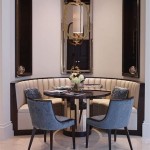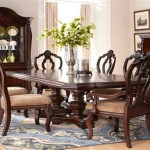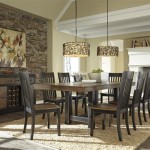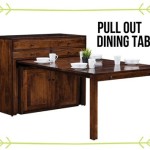Decoding the Picture of A Dining Room: Design, Functionality, and Ambiance
The dining room, historically a formal space dedicated solely to dining, has evolved into a multifaceted area often integrated into the open-plan living concept. Understanding the elements within a picture of a dining room involves analyzing its design, functionality, and the overall ambiance it projects. Careful consideration of these facets allows for a comprehensive interpretation of the space and its intended purpose.
Analyzing a dining room photograph requires attention to detail, encompassing everything from the furniture arrangement and lighting to the color palette and decorative accents. Each element contributes to the overall impression and reveals clues about the homeowner's style, priorities, and the intended use of the space. Dissecting these components provides a framework for understanding the picture's message and appreciating the nuances of dining room design.
I. Furniture: The Foundation of the Dining Room
The centerpiece of any dining room is undoubtedly the dining table. Its size, shape, and material are primary indicators of the room's capacity and style. A large rectangular table suggests formal gatherings and accommodates a greater number of guests, while a round or square table fosters a more intimate and conversational atmosphere. The material of the table, whether wood, glass, metal, or a composite, further dictates the room's aesthetic, ranging from rustic and traditional to modern and minimalist.
Dining chairs are equally important, contributing to both the comfort and visual appeal of the room. Their style should complement the table, creating a cohesive and harmonious look. Upholstered chairs offer greater comfort for extended dining experiences, while simpler designs prioritize practicality and ease of maintenance. The number of chairs surrounding the table directly reflects the regular occupancy and the potential for hosting guests.
Additional furniture pieces, such as sideboards, buffets, and china cabinets, serve functional and decorative purposes. They provide storage for tableware, linens, and serving dishes, while also offering opportunities to display decorative objects and artwork. The style of these pieces should align with the overall design scheme, enhancing the room's character and functionality. A well-chosen sideboard can act as a focal point, drawing the eye and adding visual interest to the space.
Careful consideration of the scale and proportion of furniture is crucial. Overly large furniture in a small dining room can create a cramped and uncomfortable atmosphere, while undersized pieces in a large space can appear lost and insignificant. The furniture arrangement should allow for comfortable circulation and easy access to all parts of the room. A well-planned layout maximizes space and enhances the dining experience.
II. Lighting: Illuminating the Ambiance
Lighting plays a crucial role in setting the mood and highlighting the architectural features of a dining room. A well-lit dining room is inviting and conducive to comfortable conversation and enjoyable meals. The lighting scheme should incorporate a combination of ambient, task, and accent lighting to create a balanced and layered effect.
Ambient lighting provides overall illumination to the room, typically achieved through chandeliers, pendant lights, or recessed lighting. Chandeliers are often positioned above the dining table, serving as a focal point and providing a warm and inviting glow. Pendant lights offer a more modern alternative, while recessed lighting provides a subtle and unobtrusive source of light. The intensity of ambient lighting should be adjustable to accommodate different dining scenarios and preferences.
Task lighting focuses on specific areas, such as the dining table or a sideboard, to facilitate activities like serving, eating, and reading. Table lamps, sconces, and spotlights can be used to provide targeted illumination. Dimmer switches are essential for controlling the intensity of task lighting and creating a more intimate atmosphere during meals. The color temperature of the light should be warm and inviting, promoting relaxation and enhancing the dining experience.
Accent lighting is used to highlight architectural details, artwork, or decorative objects. Wall washers, spotlights, and picture lights can be used to draw attention to specific elements within the room. Accent lighting adds depth and dimension to the space, creating visual interest and enhancing the overall aesthetic. The placement and direction of accent lighting should be carefully considered to achieve the desired effect.
Natural light is also an important factor to consider. Large windows and skylights can provide ample natural light during the day, creating a bright and airy atmosphere. Window treatments, such as curtains, blinds, or shades, can be used to control the amount of natural light entering the room and provide privacy. The orientation of the room and the surrounding environment will influence the availability of natural light and the need for artificial lighting.
III. Color Palette and Decorative Accents: Defining the Style
The color palette of a dining room sets the tone and influences the overall ambiance. Warm colors, such as reds, oranges, and yellows, create a cozy and inviting atmosphere, while cool colors, such as blues, greens, and purples, promote a sense of calm and serenity. Neutral colors, such as whites, grays, and beiges, provide a versatile backdrop for bolder accents and allow for greater flexibility in decorating.
The choice of colors should be influenced by the size and orientation of the room, as well as the desired mood. Lighter colors can make a small room appear larger and brighter, while darker colors can add depth and drama to a larger space. The use of contrasting colors can create visual interest and highlight specific features. The color palette should also complement the furniture, flooring, and other decorative elements.
Decorative accents add personality and character to the dining room. Artwork, mirrors, plants, and decorative objects can be used to personalize the space and reflect the homeowner's style. Artwork can serve as a focal point, adding color, texture, and visual interest. Mirrors can create the illusion of more space and reflect light, making the room feel brighter and more open. Plants can add a touch of nature and create a more relaxing atmosphere.
Table linens, such as tablecloths, placemats, and napkins, are essential for setting the table and adding a touch of elegance. The choice of linens should complement the tableware and the overall design scheme. Simple and understated linens are suitable for casual dining, while more elaborate and luxurious linens are appropriate for formal occasions. The use of texture and pattern can add visual interest and enhance the dining experience.
Wall coverings, such as paint, wallpaper, or paneling, can significantly impact the look and feel of the dining room. Paint is a versatile and affordable option, offering a wide range of colors and finishes. Wallpaper can add texture, pattern, and visual interest. Paneling can create a more formal and traditional look. The choice of wall covering should complement the furniture, lighting, and other decorative elements.
Flooring is another important element to consider. Hardwood floors are a classic and durable option, adding warmth and elegance to the dining room. Tile floors are a practical and easy-to-clean choice, suitable for high-traffic areas. Carpeting can add softness and warmth, but requires more maintenance. The choice of flooring should complement the overall design scheme and be appropriate for the intended use of the space.
Analyzing a picture of a dining room involves a holistic approach, considering the interplay of furniture, lighting, color, and decorative accents. Each element contributes to the overall aesthetic and functionality of the space, reflecting the homeowner's style and priorities. By carefully examining these components, a deeper understanding of the dining room's design and intended purpose can be achieved.

Expert Advice How To Design A Perfectly Scaled Dining Room The Kuotes Blog

10 Formal Dining Room Ideas From Top Designers

90 Unique Dining Room Ideas Layouts And Decorating Tips

14 Must Try Dining Room Ideas For Hosting In Style Decorilla Online Interior Design

Dining Room Layout Dimensions For Your Home Designcafe

60 Dining Room Ideas That Will Make You Swear Off Tv Dinners

80 Elevated Dining Room Ideas Perfect For Entertaining In 2025

Cozy Christmas Dining Room Decorating Ideas Sanctuary Home Decor

Dining Room Inspiration Farrow Ball

10 Formal Dining Room Ideas From Top Designers








